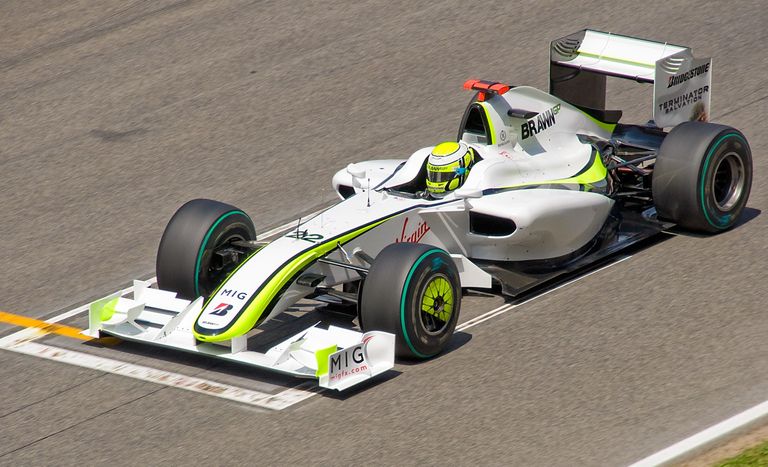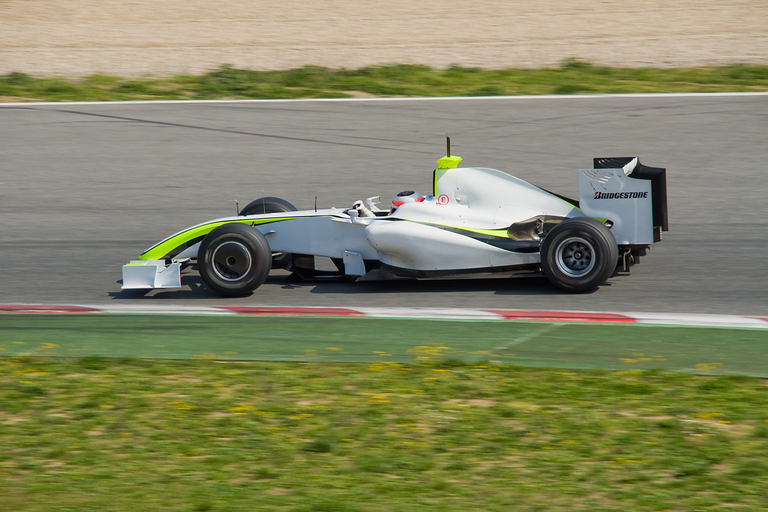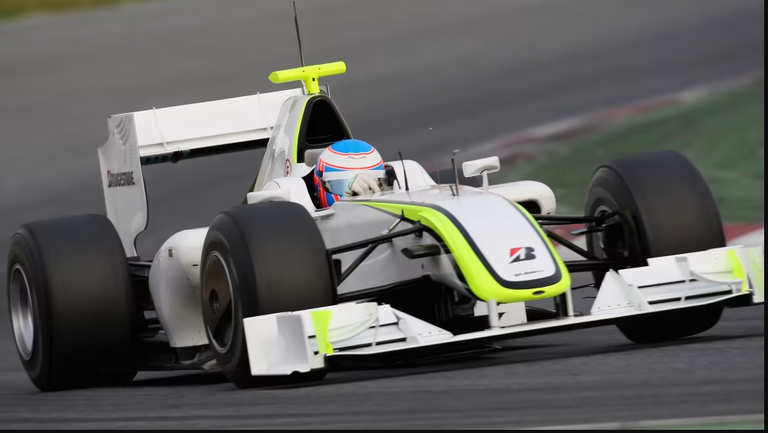
La historia del equipo Brawn es una paradoja en sí misma.
Es una de esas historias difíciles de creer si uno analiza los recursos a disposición y lo que significa ganar todo (Campeonato Pilotos y Constructores en la Fórmula Uno).
Por el modo en que consiguió estos logros. Por su vida deportiva efímera.
Porque nació prácticamente de la nada. Sin esponsors previos (los consiguió a último momento), sin una campaña en la que estuvieron involucrados los mass media con toda su potencia. Con un equipo ténico también armado a último momento. Y teniendo que luchar constra "monstruos" como Ferrari, Red Bull y McLaren entre otros.
Pero vayamos por partes para entender esta historia.

The story of the Brawn team is a paradox in itself.
It is one of those stories that is hard to believe if you look at the resources at its disposal and what it means to win it all (Drivers' and Constructors' Championship in Formula One).
For the way in which he achieved these accomplishments. For his ephemeral sporting life.
Because it was born practically from nothing. Without previous sponsors (he got them at the last minute), without a campaign in which the mass media was involved with all its power. With a technical team also put together at the last minute. And having to fight against "monsters" like Ferrari, Red Bull and McLaren among others.
But let's go by parts to understand this story.
Los inicios de la aventura. / The beginnings of the adventure.
Ross James Brawn en ese momento era el director deportivo de Honda, un fichaje que había despertado un enorme interés en el ambiente de la Fórmula 1 ya que hasta entonces el ingeniero británico desde siempre ligado a la máxima categoría del automovilismo deportivo (antes en Lotus, Lola, Arrows y Benetton) había sido el director deportivo de Ferrari durante una década (1997-2006) contribuyendo no solo a cimentar el "reinado" de Michael Schumacher como piloto sino también de Ferrari como equipo, en un predominio total.
Cuando Honda (como equipo y no como proveedor de motores) debido a los magros resultados y al no ser redituable su participación debido a los altos costos anunció su abandono de la Fórmula 1 Brawn decide de comprar por el valor simbólico de 1 USD el equipo el 6/3/2009 cuando faltaban pocos días para el inicio de la temporada.
Se asegura en los ambientes ligados estrechamente a la Fórmula 1 que la espectacularidad del anuncio en realidad tenía bases muy fundadas ya que ante la inminencia del abandono de Honda Brawn había comenzado a preparar a preparar su estrategia con mucha anticipación.
Si pensamos lo que cuesta a los nuevos equipos de F1 adaptarse a su rol (Aston Martin, Alphine, Haas) aún contando con una sólida experiencia y actuaciones precedentes relativamente confortantes, imaginemos la aventura en el 2009 con mucha menos técnica a disposición y con recursos tremendamente limitados.

Ross James Brawn at that time was the sporting director of Honda, a signing that had aroused enormous interest in the Formula 1 environment since until then the British engineer had always been linked to the highest category of motorsport (previously at Lotus, Lola, Arrows and Benetton) and had been the sporting director of Ferrari for a decade (1997-2006) contributing not only to cement the "reign" of Michael Schumacher as a driver but also of Ferrari as a team, in a total dominance.
When Honda (as a team and not as an engine supplier), due to the poor results and not being profitable due to the high costs, announced its abandonment of Formula 1, Brawn decided to buy the team for the symbolic value of 1 USD on March 6, 2009, just a few days before the start of the season.
It is said in the circles closely linked to Formula 1 that the spectacular nature of the announcement actually had a very well-founded basis, since Brawn had begun to prepare its strategy well in advance of the imminent abandonment of Honda.
If we think how hard it is for new F1 teams to adapt to their role (Aston Martin, Alphine, Haas) even if they have a solid experience and relatively comforting previous performances, imagine the adventure in 2009 with much less technique at their disposal and with extremely limited resources.
De sorpresa en sorpresa. / From surprise to surpris.

Todavía no se habían acallado los ecos de la sorpresa cuando menos de un mes más tarde se produce el debut en Australia con dos pilotos relativamente veteranos: Jenson Button (29 años) y Rubens Barricchello 37 años). El primero de niño prodifio había pasado a perderse en los laberintos de distintos equipos sin poder llegar a destacarse más alla del segundo o tercer grupo de pilotos. Barricchello ya estaba pensando más en retirarse que en seguir.
No solo gana Jenson Button (la segunda de su carrera deportiva en F1) sino que Rubens Barricchello lo sigue a apenas un par de décimos. Completa el podio Sebastian Vettel con Red Bull.
Si inesperada fue la victoria más increíble aún es que el auto, a excepción de la marca de pneumáticos que proveía de los mismo a la entera categoría, no tenía ningún tipo de exponsor. Una máquina totalmente blanca.
Asombro generalizado. Ferrari es la primera en reaccionar diciendo que los difusores de aire utilizados por Brawn era ilegales, o mejor dicho, no reglamentarios. Siguieron otras denuncias.
Intervino la FIA para dirimir la cuestión y, después de algunos meses, en Julio de 2009 dictaminó que los difusores de aire, la ténica innovativa de Brawn que permetía una mejor adherencia al suelo del monoplaza sobre todo en las curvas y le permitía encarar los rectilíneos con una mayor velocidad no sono era legal sino que representaba una interesante innovación en la F1. Simplemente porque no había nada en los reglamentos de la FIA que lo prohibiera. Era un nuevo "invento" en la tecnológica F1 que le permitían a los monoplazas Brawn de ganar medio segundo por vuelta y por lo tanto el mérito y el resultado deportivo iba a su autor.
El resto de los equipos no logró reaccionar a tiempo más preocupados por ganar la batalla legal que la batalla técnica. Y Brawn supo aprovechar este error de valuación por parte de sus rivales.
Richard Branson dueño de Virgin fue el primero en darle su apoyo, al cuál se fueron agregando otros patrocinadores a medida que el sueños de ganar el campeonato se iba transformando en realidad. La multinacional Canon fue una de las últimas en patrocinar el BGP 001.

The echoes of the surprise had not yet died down when, less than a month later, two relatively veteran drivers made their debut in Australia: Jenson Button (29 years old) and Rubens Barricchello (37 years old). The former had gone from being a child prodigy to getting lost in the labyrinths of different teams without being able to stand out beyond the second or third group of drivers. Barricchello was already thinking more about retiring than continuing.
Not only Jenson Button wins (the second of his F1 career) but Rubens Barricchello follows him just a couple of tenths behind. Sebastian Vettel with Red Bull completes the podium.
If the victory was unexpected, even more incredible is that the car, except for the brand of tires that provided the same to the entire category, had no sponsor. A totally white machine.
General astonishment. Ferrari was the first to react, saying that the air diffusers used by Brawn were illegal, or rather, unregulated. Other complaints followed.
The FIA intervened to settle the issue and, after a few months, in July 2009 ruled that the air diffusers, Brawn's innovative technique that allowed a better grip to the ground of the car especially in the corners and allowed him to face the straights with a higher speed was not only legal but represented an interesting innovation in F1. Simply because there was nothing in the FIA regulations that prohibited it. It was a new "invention" in the F1 technology that allowed the Brawn cars to gain half a second per lap and therefore the merit and the sporting result went to its author.
The rest of the teams failed to react in time, more concerned about winning the legal battle than the technical battle. And Brawn knew how to take advantage of this error of valuation on the part of its rivals.
Richard Branson, owner of Virgin, was the first to support Brawn, to which other sponsors were added as the dream of winning the championship became a reality. The multinational Canon was one of the last to sponsor the BGP 001.
El campeonato. / The championship.
El campeonato terminó como había iniciado aunque ya el predominio de Braw comenzaba a vacilar. Jenson Button ganó el Campeonato de Pilotos de F1 con 85 puntos (la puntuación en ese momento era de 10 puntos por victoria) producto de 5 victorias. Aunque en las últimas 6 carreras sacó solo 17 puntos. Mientras que en las primeras 6 había obtenido 51 puntos. Ya los "pesos pesados" comenzaban a acercarse y a ganar terreno.
Vettel (Red Bull) estuvo muy cerca de sacarle la segunda posición a Barricchello que hizo el 1-2 de pilotos con 71 puntos.
Al alemán lo le alcanzaron los 69 puntos pero igual se subió al podio final. Atrás quedaron Webber, Raikkonen, Hamilton, Rosberg, Trulli, Alonso y Glock para completar la Top Ten.
Brawn también ganó el Mundial de Constructores con bastante comodidad, con 156 puntos. Segundo fue Red Bull con 120.5 puntos y tercero Ferrari con solo 67 puntos. Muy cerca McLaren con 65
Eran los años en los cuáles Williams todavía cosechaba puntos que le permitían ubicarse en el pelotón intermedio. Toro Rosso (5), Force India (13) y Sauber (24) luchaban por los últimos lugares pero cosechando puntos todos. Ya en esa época cada punto en F1 valía mucho dinero.

The championship ended as it had started although Braw's dominance was already beginning to waver. Jenson Button won the F1 Drivers' Championship with 85 points (the score at that time was 10 points per win) from 5 victories. Although in the last 6 races he scored only 17 points. While in the first 6 he had scored 51 points. Already the "heavyweights" were starting to get closer and gain ground.
Vettel (Red Bull) was very close to take the second position from Barricchello, who made the 1-2 of drivers with 71 points.
The German was not enough with 69 points, but he still made it to the final podium. Behind him were Webber, Raikkonen, Hamilton, Rosberg, Trulli, Alonso and Glock to complete the Top Ten.
Brawn also won the Constructors' World Championship quite comfortably with 156 points. Second was Red Bull with 120.5 points and third Ferrari with only 67 points. Close behind McLaren with 65
Those were the years in which Williams still scored points that allowed them to be in the middle group. Toro Rosso (5), Force India (13) and Sauber (24) were fighting for the last places but all of them were scoring points. Back then, every point in F1 was worth a lot of money.
Historia reciente. / Recent history.
Lo demás es historia más conocida. Brawn convencido que los demás equipos utilizarían su invención (o que ésta sería definitivamente prohibida por la FIA) ya se había dado cuenta en las últimas carreras que volver a ganar sería una utopía.
Podía soprender a Red Bull, McLaren o Ferrari una vez. Sorprenderlos dos veces sería mucho más difícil.
Por eso decide, apenas terminada la temporada de vender el 75% de sus acciones a Mercedes que ya estaba pensando en desvincularse de McLaren y crear su propio equipo.
El valor total de la operación fue por un valor de 100 millones de dólares. Un negocio fantástico. Con el agregado que Brawn para a ser el director deportivo de Mercedes hasta el año 2014 en que es reemplazado por Toto Wolff.

The rest is more familiar history. Brawn convinced that the other teams would use his invention (or that it would be definitively banned by the FIA) had already realized in the last races that winning again would be a utopia.
He could surprise Red Bull, McLaren or Ferrari once. Surprising them twice would be much more difficult.
That is why he decided, as soon as the season was over, to sell 75% of his shares to Mercedes, which was already thinking of disassociating itself from McLaren and creating its own team.
The total value of the operation was 100 million dollars. A fantastic deal. With the addition that Brawn to become the sporting director of Mercedes until 2014 when he is replaced by Toto Wolff.

Translated with www.DeepL.com/Translator (free version)
Fuentes imagenes / Sources images:
- Formula1.
- Wikipedia.
Posted from https://blurtlatam.intinte.org